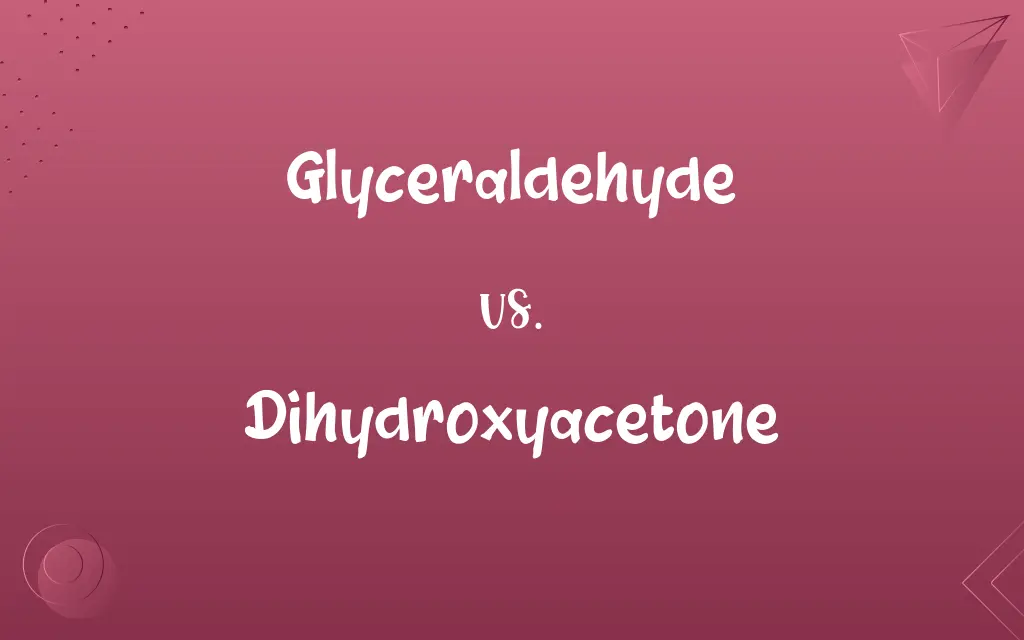Glyceraldehyde vs. Dihydroxyacetone: Know the Difference

By Shumaila Saeed || Updated on December 25, 2023
Glyceraldehyde is a simple sugar with one chiral center, while dihydroxyacetone, a ketose sugar, lacks chirality and is the simplest ketone.

Key Differences
Glyceraldehyde is a triose, the simplest of all monosaccharides, containing three carbon atoms. It has one chiral center, making it optically active and existing in two stereoisomers (D- and L-forms). Dihydroxyacetone, also a triose, is the simplest ketone sugar, but unlike glyceraldehyde, it does not have any chiral centers and is not optically active.
Shumaila Saeed
Dec 18, 2023
In the structure of glyceraldehyde, the presence of a chiral center gives rise to its optical isomerism. This feature plays a crucial role in biochemistry, particularly in carbohydrate metabolism. Dihydroxyacetone, while structurally similar to glyceraldehyde, lacks this chiral center, leading to different chemical and biological properties.
Shumaila Saeed
Dec 18, 2023
Glyceraldehyde is involved in several important biochemical pathways, including glycolysis and the Calvin cycle, where it plays a crucial role in energy and biomass production in cells. Dihydroxyacetone, on the other hand, is used in the cosmetic industry as an ingredient in self-tanning products, owing to its ability to induce a color change in the skin.
Shumaila Saeed
Dec 18, 2023
The chemical reactivity of glyceraldehyde is characterized by its aldehyde group, which is reactive and can be oxidized or reduced in biochemical reactions. In contrast, dihydroxyacetone features a ketone group, which, while still reactive, undergoes different types of chemical reactions compared to an aldehyde group.
Shumaila Saeed
Dec 18, 2023
From a biological perspective, glyceraldehyde is a fundamental building block in the synthesis of other carbohydrates. It can be phosphorylated to form glyceraldehyde-3-phosphate, a key intermediate in several metabolic pathways. Dihydroxyacetone, though less prominent in metabolic pathways, is important in glycolysis, where it is interconvertible with glyceraldehyde-3-phosphate.
Shumaila Saeed
Dec 18, 2023
ADVERTISEMENT
Comparison Chart
Type of Sugar
Aldose (contains an aldehyde group).
Ketose (contains a ketone group).
Shumaila Saeed
Dec 18, 2023
Chirality
Has one chiral center, optically active.
No chiral centers, not optically active.
Shumaila Saeed
Dec 18, 2023
Role in Metabolism
Involved in glycolysis and Calvin cycle.
Interconvertible with G-3-P in glycolysis.
Shumaila Saeed
Dec 18, 2023
Chemical Reactivity
Aldehyde group can be oxidized or reduced.
Ketone group undergoes different reactions.
Shumaila Saeed
Dec 18, 2023
Industrial Use
Less commonly used in industry.
Used in self-tanning products.
Shumaila Saeed
Dec 18, 2023
ADVERTISEMENT
Glyceraldehyde and Dihydroxyacetone Definitions
Glyceraldehyde
A simple monosaccharide with three carbon atoms and a chiral center.
Glyceraldehyde plays a vital role in the Calvin cycle of plants.
Shumaila Saeed
Dec 11, 2023
Dihydroxyacetone
Involved in glycolysis, interconvertible with glyceraldehyde-3-phosphate.
Dihydroxyacetone phosphate is a key intermediate in metabolic pathways.
Shumaila Saeed
Dec 11, 2023
Glyceraldehyde
Exists in two isomeric forms due to its chiral carbon atom.
The D- and L-forms of glyceraldehyde are mirror images of each other.
Shumaila Saeed
Dec 11, 2023
Dihydroxyacetone
A triose sugar that reacts with skin amino acids to produce a tan.
Dihydroxyacetone's interaction with skin proteins results in a bronzed look.
Shumaila Saeed
Dec 11, 2023
Glyceraldehyde
The smallest aldose, important in energy-producing pathways.
In glycolysis, glyceraldehyde-3-phosphate is a key intermediate.
Shumaila Saeed
Dec 11, 2023
ADVERTISEMENT
Dihydroxyacetone
A biochemically significant ketone in carbohydrate metabolism.
Dihydroxyacetone plays a role in the energy production process of cells.
Shumaila Saeed
Dec 11, 2023
Glyceraldehyde
A critical substrate in various biochemical reactions.
Enzymatic reactions often involve the conversion of glyceraldehyde.
Shumaila Saeed
Dec 11, 2023
Dihydroxyacetone
The simplest ketose sugar, not optically active due to no chiral center.
Dihydroxyacetone is often used in self-tanning lotions.
Shumaila Saeed
Dec 11, 2023
Glyceraldehyde
A fundamental building block in the synthesis of carbohydrates.
Glyceraldehyde can be phosphorylated during metabolic processes.
Shumaila Saeed
Dec 11, 2023
Dihydroxyacetone
Used in cosmetic industry due to its skin-coloring properties.
Many tanning products contain dihydroxyacetone as the active ingredient.
Shumaila Saeed
Dec 11, 2023
Glyceraldehyde
A sweet colorless crystalline solid, C3H6O3, that is an intermediate compound in carbohydrate metabolism.
Shumaila Saeed
Dec 10, 2023
Dihydroxyacetone
(organic compound) The compound CO(CH2OH)2 that has a number of industrial uses
Shumaila Saeed
Dec 10, 2023
Glyceraldehyde
(carbohydrate) The aldotriose 2,3-dihydroxypropanal formed by oxidation of glycerol
Shumaila Saeed
Dec 10, 2023
Glyceraldehyde
A sweet crystalline aldehyde formed by the breakdown of sugars
Shumaila Saeed
Dec 10, 2023
Repeatedly Asked Queries
What role does glyceraldehyde play in metabolism?
It's involved in energy and biomass production.
Shumaila Saeed
Dec 18, 2023
Are glyceraldehyde and dihydroxyacetone isomers?
Yes, they are structural isomers.
Shumaila Saeed
Dec 18, 2023
What is dihydroxyacetone used for?
Mainly in self-tanning products and in glycolysis.
Shumaila Saeed
Dec 18, 2023
Is dihydroxyacetone a natural compound?
Yes, it occurs naturally in some glycolytic pathways.
Shumaila Saeed
Dec 18, 2023
How is glyceraldehyde-3-phosphate related to glyceraldehyde?
It's the phosphorylated form of glyceraldehyde.
Shumaila Saeed
Dec 18, 2023
Can dihydroxyacetone cause skin irritation?
It can in some sensitive individuals.
Shumaila Saeed
Dec 18, 2023
Can dihydroxyacetone be used in food?
It's generally recognized as safe but not commonly used as a food additive.
Shumaila Saeed
Dec 18, 2023
Can glyceraldehyde exist in multiple forms?
Yes, as D- and L-isomers due to its chiral center.
Shumaila Saeed
Dec 18, 2023
Is glyceraldehyde an important sugar in biology?
Yes, especially in photosynthesis and glycolysis.
Shumaila Saeed
Dec 18, 2023
What is the difference in the molecular formula of glyceraldehyde and dihydroxyacetone?
They share the same molecular formula, C3H6O3.
Shumaila Saeed
Dec 18, 2023
How does glyceraldehyde contribute to the Calvin cycle?
It's part of the cycle of carbon fixation in plants.
Shumaila Saeed
Dec 18, 2023
Can glyceraldehyde be synthesized artificially?
Yes, through several chemical synthesis methods.
Shumaila Saeed
Dec 18, 2023
What precautions are needed when using dihydroxyacetone?
Avoid inhalation and contact with eyes.
Shumaila Saeed
Dec 18, 2023
How does dihydroxyacetone produce a tan?
It reacts with amino acids in the skin, causing a color change.
Shumaila Saeed
Dec 18, 2023
Is dihydroxyacetone toxic?
It's considered safe for topical use but should be avoided in the eyes and mouth.
Shumaila Saeed
Dec 18, 2023
Can dihydroxyacetone be found in the human body?
Yes, as an intermediate in certain metabolic pathways.
Shumaila Saeed
Dec 18, 2023
Why is dihydroxyacetone not optically active?
Due to the absence of a chiral center.
Shumaila Saeed
Dec 18, 2023
Share this page
Link for your blog / website
HTML
Link to share via messenger
About Author
Written by
Shumaila SaeedShumaila Saeed, an expert content creator with 6 years of experience, specializes in distilling complex topics into easily digestible comparisons, shining a light on the nuances that both inform and educate readers with clarity and accuracy.








































































